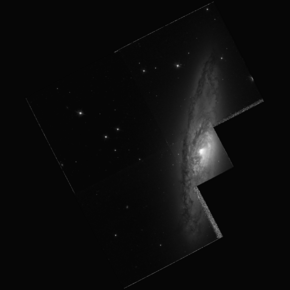| NGC 6810 | |
|---|---|
 NGC 6810 | |
| Observation data (J2000.0 epoch) | |
| Constellation | Pavo |
| Right ascension | 19h 43m 34.25s [1] |
| Declination | −58° 39′ 20.12″ [1] |
| Redshift | 0.006775 [1] |
| Heliocentric radial velocity | 2031 ± 10 km/s [1] |
| Distance | 87 Mly [1] |
| Apparent magnitude (V) | 11.60 [2] |
| Apparent magnitude (B) | 12.40 [2] |
| Characteristics | |
| Type | SA(s)ab:sp [1] |
| Apparent size (V) | 3.2 x 0.9 [1] |
| Other designations | |
| PGC 63571, ESO 142-35 | |
NGC 6810 is a spiral galaxy approximately 87 million light-years away from Earth in the constellation of Pavo. [1]